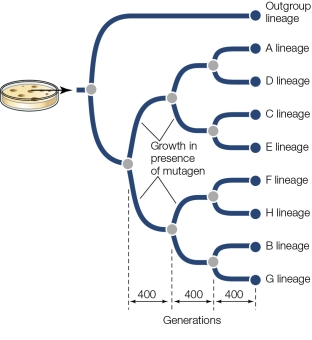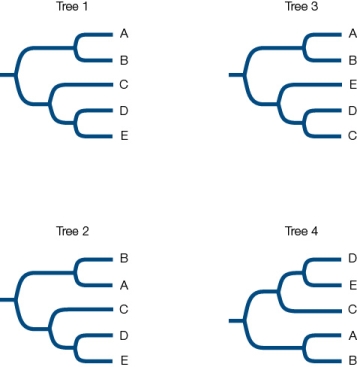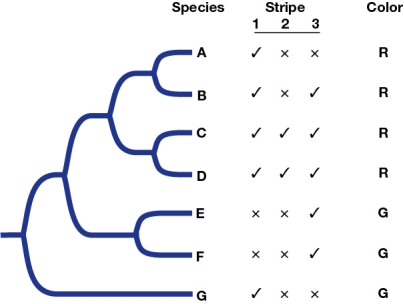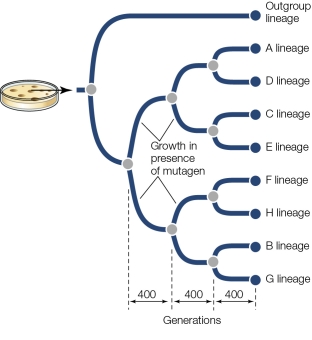Correct Answer

verified
Correct Answer
verified
Multiple Choice
Consider five species of toads (A-E) .Species A and B are sister species.Species C and D are also sister species.The clade containing species A and B is a sister to the clade containing species C and D.Not counting the root as a node, how many nodes would be found in a phylogenetic tree of species A, B, C, D, and E?
A) One
B) Two
C) Three
D) Four
E) Five
Correct Answer

verified
Correct Answer
verified
Multiple Choice
Which is a property of HIV that would make it difficult to trace the source of the virus from one person to the next?
A) The host can have a genetically diverse population of viruses.
B) HIV evolves very slowly within the host.
C) The transmission of the virus involves very few (often just one) viral particles.
D) Molecular phylogenies of viruses cannot be constructed.
E) The population of HIV is too small to trace.
Correct Answer

verified
Correct Answer
verified
Multiple Choice
Consider five species of toads (A-E) .Species A and B are sister species.Species C and D are also sister species.The clade containing species A and B is a sister to the clade containing species C and D.Not counting the root as a node, how many nodes would be found in a phylogenetic tree of species A, B, and C?
A) One
B) Two
C) Three
D) Four
E) Five
Correct Answer

verified
Correct Answer
verified
Multiple Choice
Refer to the figure showing a single viral plaque that was split every 400 generations and grown in the presence of a mutagen.  How many generations of evolution have occurred between the A lineage and the C lineage? Remember that evolution is occurring in both lineages.
How many generations of evolution have occurred between the A lineage and the C lineage? Remember that evolution is occurring in both lineages.
A) 400
B) 800
C) 1,200
D) 1,600
E) 3,200
Correct Answer

verified
Correct Answer
verified
Short Answer
Phylogenetic analysis shows that HIV most likely was transmitted to humans from _______ species of nonhuman primates.
Correct Answer

verified
Correct Answer
verified
Multiple Choice
In modern systematics, each family name is based on
A) the name of a member genus.
B) a characteristic common to all members.
C) the name of the order to which the family belongs.
D) the name of the largest member species.
E) the Latin name for the organisms.
Correct Answer

verified
Correct Answer
verified
Multiple Choice
The wasp genus Nasonia contains all of the descendants of the common ancestor of its members.This genus therefore would be called
A) a clade.
B) a polyphyly.
C) a synapomorphy.
D) parsimonious.
E) self-compatible.
Correct Answer

verified
Correct Answer
verified
Multiple Choice
Several distantly related clades of a family of plants have smooth fleshy leaves, whereas most plants related to the plants with fleshy leaves do not have this trait.Without any further information, the least parsimonious explantation for this is that the fleshy leaves
A) evolved due to convergent evolution.
B) are a homologous feature within this family.
C) are a homoplastic trait within this family.
D) are examples of evolutionary reversals.
E) are due to a change in a single gene.
Correct Answer

verified
Correct Answer
verified
Multiple Choice
Four different phylogenetic trees of a group of salamanders have been proposed.Trees A and B each require 19 homoplasies, but tree A requires 16 synapomorphies, and tree B requires 15 synapomorphies.Tree C requires 15 homoplasies and 18 synapomorphies.Finally, tree D requires 22 homoplasies and 9 synapomorphies.According to the principle of parsimony, which tree or trees is/are the best?
A) Tree A
B) Tree B
C) Tree C
D) Tree D
E) Both tree A and tree B are equally good, and better than the others.
Correct Answer

verified
Correct Answer
verified
Multiple Choice
Refer to the figure.  Which of these phylogenetic trees conveys different phylogenetic information from the others?
Which of these phylogenetic trees conveys different phylogenetic information from the others?
A) Tree 1
B) Tree 2
C) Tree 3
D) Tree 4
E) All of the trees convey the same information.
Correct Answer

verified
Correct Answer
verified
Multiple Choice
Recall the Hillis et al.experiments that tested the accuracy of methods used in phylogenetic analysis.If even more mutagens had been added, the rate of evolution would have been _______, there would have been _______ expected homoplasies, and the accuracy of the phylogenetic analysis most likely would have been _______ than what was observed.
A) higher; more; better
B) higher; more; worse
C) higher; fewer; better
D) lower; more; worse
E) lower; fewer; better
Correct Answer

verified
Correct Answer
verified
Multiple Choice
Consider five species of toads (A-E) .Species A and B are sister species.Species C and D are also sister species.The clade containing species A and B is a sister to the clade containing species C and D.Not counting the root as a node, how many nodes would be found in a phylogenetic tree of species A, B, C, and D?
A) One
B) Two
C) Three
D) Four
E) Five
Correct Answer

verified
Correct Answer
verified
Multiple Choice
Refer to the figure.  In the clade that contains species A, B, C, and D, species _______ would be part of the ingroup, and species _______ would be an outgroup.
In the clade that contains species A, B, C, and D, species _______ would be part of the ingroup, and species _______ would be an outgroup.
A) A; B
B) A; E
C) E; A
D) E; D
E) E; F
Correct Answer

verified
Correct Answer
verified
Short Answer
A taxon of beetles includes the common ancestor and some, but not all, of its descendants.This taxon is a _______ group.
Correct Answer

verified
Correct Answer
verified
Short Answer
Refer to the figure showing a single viral plaque that was split every 400 generations and grown in the presence of a mutagen.  Which lineage would likely share the most synapomorphies with lineage F?
Which lineage would likely share the most synapomorphies with lineage F?
Correct Answer

verified
Correct Answer
verified
Short Answer
Your colleague has incorrectly written a species of dwarf salamander as eurycea Hillisi.Based on the rules of binomial nomenclature, _______ is the proper way to write the species name.
Correct Answer

verified
Correct Answer
verified
Multiple Choice
There are five species of beetles.Species A and B have red colored wings, whereas species C and D have pale wings and species E lacks wings completely.Which piece of evidence would best support the hypothesis that red wings are a synapomorphy?
A) Evidence from morphology unrelated to wings that A and B are sister species.
B) DNA evidence showing that species B and D are sister species.
C) Fossil evidence showing that the common ancestor of all five species lacked wings.
D) Fossil evidence showing that the common ancestor of all five species had red wings.
E) Evidence showing that species A and B live in an environment that favors red wings, whereas the other three species live in an environment that favors pale wings
Correct Answer

verified
Correct Answer
verified
Multiple Choice
In their studies testing the accuracy of phylogenetic methods, Hillis and colleagues split the culture virus into two separate lineages.Why did they do this?
A) To obtain an ingroup and an outgroup
B) To increase the amount of homoplasy
C) To decrease the amount of homoplasy
D) To increase the accuracy of the results
E) To enable the use of maximum likelihood analysis
Correct Answer

verified
Correct Answer
verified
Short Answer
A well-funded team of biologists have collected data on a number of different anatomical features of a group of marine gastropods.Prior work has shown that the rates of evolution of different features vary widely.Based on this, the biologists should use _______ methods in the analysis of their data.
Correct Answer

verified
Correct Answer
verified
Showing 181 - 200 of 246
Related Exams